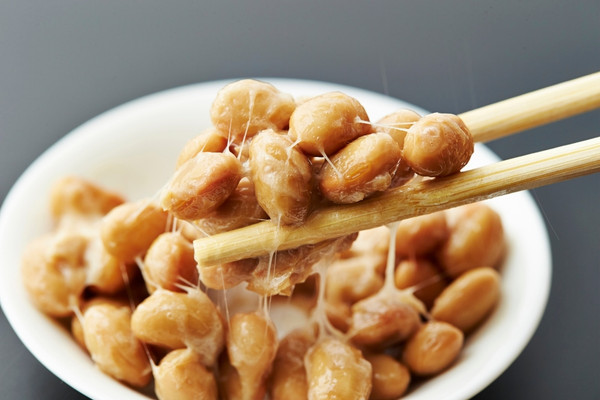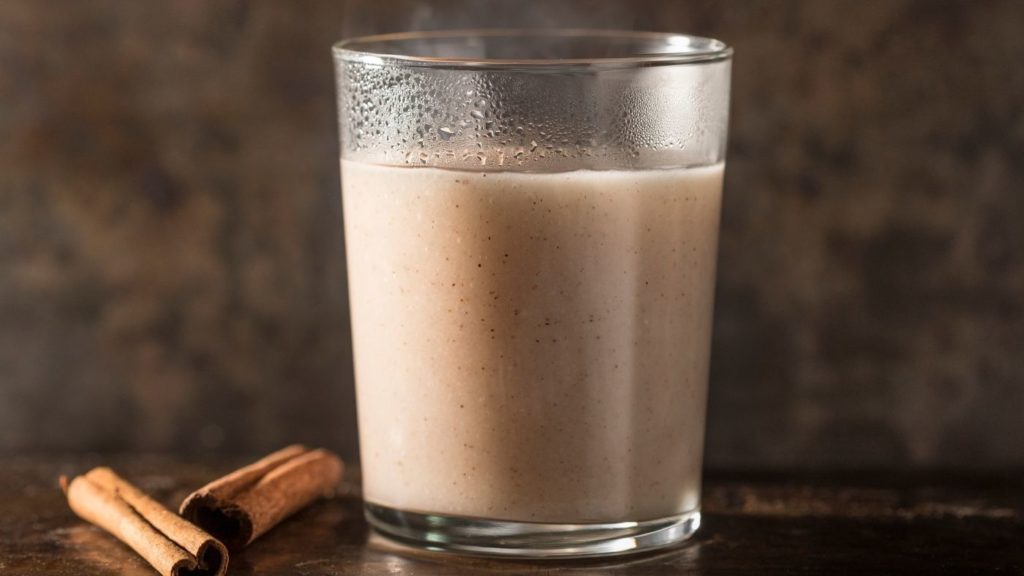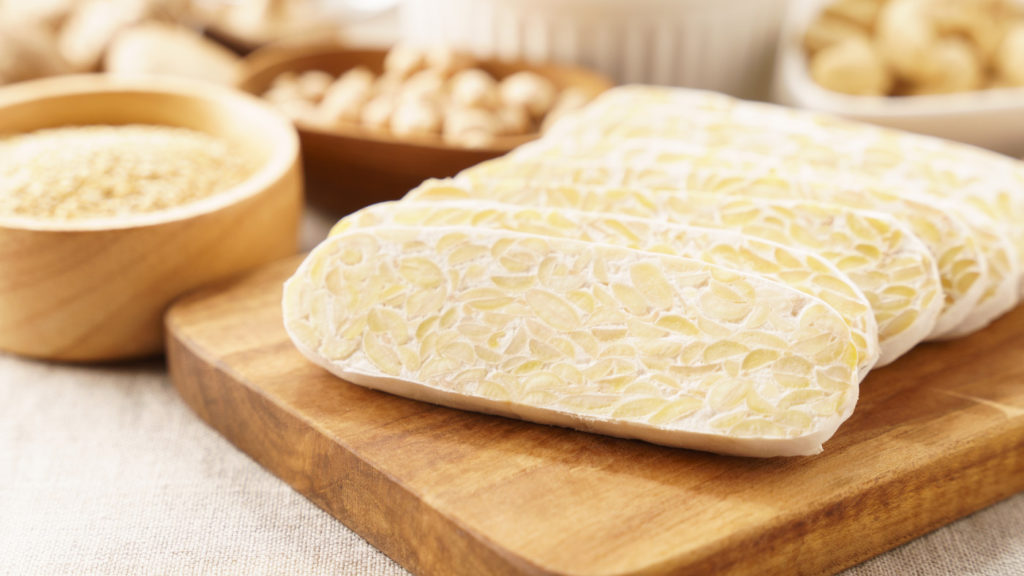Discover the benefits of natto, this superfood rich in vitamin K2 and nattokinase.
Natto is a traditional Japanese food made from soybeans with a surprising texture! Hidden behind its neutral taste and endless strings lies a wealth of health benefits! Natto, a Japanese staple, is now making its way around the world.
In a nutshell, natto is a fermented food rich in proteins, enzymes (nattokinase), and vitamins (it is by far the largest source of vitamin K2). Consumed for hundreds of years in Japan, science is becoming more and more interested in its benefits for the heart, bones, and overall body.
For all the details, read on.
- What is natto?
- Natto is rich in nutrients
- Natto is good for your bones because of the vitamin K2
- Natto is good for cardiovascular health
- Natto is good for the microbiota
- Natto strengthens the immune system
- Does natto present any dangers?
- Where to find natto?
What Is Natto?
Natto is a traditional Japanese dish made from fermented soybeans.
Natto looks like cooked soybeans covered in a sticky, translucent film. When natto is mixed, the film forms strings that stretch endlessly, much like cheese in pasta!
Natto has a strong smell, but a very neutral flavour. It has a slight bitterness and an earthy, nutty flavour. In Japan, natto is served at breakfast, on a bowl of rice, and seasoned with mustard, soy sauce, and green onions.
Although the smell and appearance of natto may put some people off, natto regulars love it and can’t get enough of it! This may be an acquired taste for some.
The benefits of natto are largely due to the action of B. subtilis natto, a bacterium that transforms simple soybeans into a superfood. The bacterium was previously found on rice straw, which was used to ferment soybeans.
Nowadays, natto is made from a purchased culture.

1. Natto Is Very Nutritious
No wonder natto is commonly eaten for breakfast! It contains a large quantity of nutrients, making it an ideal food to start the day on the right foot.
Natto Is Rich in Nutrients
Natto contains mostly protein and fibre, which makes it a nutritious and sustaining food. Among the many essential nutrients contained in natto, it is particularly rich in manganese and iron.
| Nutrients | Quantity | Daily value |
|---|---|---|
| Calories | 211 kcal | |
| Protein | 19 g | |
| Fibre | 5.4 g | |
| Calcium | 217 mg | 17% |
| Iron | 8.5 mg | 47% |
| Magnesium | 115 mg | 27% |
| Manganese | 1.53 mg | 67% |
| Vitamin C | 13 mg | 15% |
| Vitamin K | 23 mcg | 19% |
Natto also contains bioactive compounds and other essential vitamins and minerals, such as zinc, B1, B2, B5, and B6 vitamins, ascorbic acid, isoflavones, etc. (ref.)
Natto Is Very Digestible
The soybeans (also called soya beans) used to make natto contain many anti-nutrients, such as phytates, lectins, and oxalates. Anti-nutrients are molecules that block the absorption of nutrients.
Fortunately, the preparation of natto (cooking and fermentation) destroys these anti-nutrients, making the soybeans easier to digest and their nutrients easier to absorb. This suddenly makes eating soybeans much more interesting! (ref.) (ref.)
Natto Produces New Nutrients
It is during fermentation that natto obtains a large part of its nutritional properties. During fermentation, the b. subtilis natto bacteria produce vitamins and release minerals. As a result, natto contains more nutrients than raw or cooked soybeans! (ref.)
Among the interesting nutrients is an impressive amount of vitamin K2 (menaquinone). Natto is one of the few plant sources that contains this vitamin!
Another nutrient unique to natto is nattokinase, an enzyme produced during fermentation.
These nutrients are being studied for their effects on heart and bone health. Read on to learn more!
2. Natto Strengthens Bones, Thanks to Vitamin K2
Natto may contribute to bone health, as it is a good source of calcium and vitamin K2 (menaquinone). But what exactly is vitamin K2? What is it used for?
Vitamin K2, also known as menaquinone, has many benefits and is naturally present in several foods, mainly in meat and cheese.
Vitamin K plays an essential role in several body mechanisms, including blood clotting, calcium transport, insulin regulation, fat deposits, DNA transcription, etc. (ref.)
Vitamin K2, in particular, has been found to aid bone density and may reduce the risk of fractures with age (ref.) (ref.). Vitamin K2 contributes to the strength and quality of bones (ref.).
There are approximately 700 micrograms of vitamin K2 per 100g of natto, over 100 times more than in unfermented soybeans (ref.) (ref.). In fact, natto has the highest levels of vitamin K2 in the world, and one of the only plant-based foods! Therefore, natto is an ideal food for people following a vegan diet, or simply for those who abstain from eating meat and cheese.
The bacteria in natto are real little vitamin factories.
3. Natto Supports Heart Health Thanks to Nattokinase
Natto’s secret weapon for supporting cardiovascular health is a unique enzyme: nattokinase.
Nattokinase is an enzyme created by bacteria found in natto. Nattokinase has many benefits and is being studied for its anticoagulant properties, as well as for its effects on cardiovascular disease (ref.). If consumed regularly, natto may help reduce heart problems and even help dissolve blood clots! (ref.)
Nattokinase is also being studied for its protective effect on thrombosis and hypertension (ref.).
Nowadays, you can even find nattokinase food supplements to support heart functions.
However, we prefer to eat natto straight! It contains fibre, probiotics, and good fats that may also help control blood cholesterol (ref.). Natto is not only a fascinating food but also a powerful heart protector!

4. Natto Strengthens the Microbiota
Natto is a food rich in prebiotics and probiotics. These two elements are essential in supporting our microbiota and immune system.
The microbiota is a collection of microorganisms that live in symbiosis with our body. The microbiota has many roles, including defending the body against pathogens, digesting, managing weight, supporting the immune system, etc. Microbiota can often be forgotten or ignored, but it is essential to our well-being (ref.).
Natto Is a Prebiotic Food
Prebiotic foods are foods that nourish the microbiota. They contain fibre and nutrients, that our internal bacteria and yeast love. By feeding our microbiota, we support its work! (ref.)
Natto is made from soybeans and therefore contains a large amount of prebiotic dietary fibre, including inulin. These can support the growth of good microorganisms once they are in our digestive system (ref.).
In addition, during fermentation, bacteria produce a substance that covers the soybeans. This substance is also perfect for feeding good bacteria in our digestive system! (ref.)
Natto Is a Source of Probiotics
Probiotic foods contain live microorganisms, which have been proven to be beneficial.
Natto contains up to one billion active bacteria per gram (ref.). These bacteria can survive their journey in our digestive system, allowing them to become part of our microbiota (ref.).
The bacteria in natto can then create all sorts of bioactive molecules, which help regulate the body and immune system (ref.).
Natto Supports the Immune System
Natto could contribute to supporting our immune system on several levels.
As mentioned above, natto supports the gut microbiota. A healthy and diverse microbiota plays an essential role in the immune system, fighting pathogens and producing antibodies (ref.).
In addition, natto contains many nutrients that can help support the immune system, such as vitamin C, manganese, selenium, zinc, etc. (ref.) (ref.)
Natto also contains antibiotic compounds that can eliminate many pathogens, such as H. pylori, S. aureus, and E. coli (ref.). Natto has been used for many years to support the immune system of breeding calves and to protect them from infection (ref.).
In humans, the bacterium b. subtilis has been studied for its protective effect on the immune system of the elderly. In one trial, participants who took the b. subtilis supplements experienced fewer respiratory infections, compared to those who took the placebo (ref.). These results are very promising!
Does Natto Present Any Dangers?
Natto may not be suitable for some people.
As natto is made from soybeans, people with soy allergies or intolerances should not consume natto.
In addition, soy is also considered a goitrogen and may not be suitable for people with hypothyroidism.
Another consideration is that natto has anticoagulant properties. If you are taking anticoagulant medication, consult a doctor before including natto in your diet.
No dosage of vitamin K2 has been associated with any toxicity (ref.).
Where to Find Natto?
Want to try natto and incorporate it into your diet? You can find it in many Asian grocery stores, in the frozen food section, or some organic grocery stores.
The majority of natto is sold in small trays, in individual portions. Many even come with seasonings, such as mustard or soy sauce.
To take it a step further, you can also make your own natto at home! It’s easy to make and inexpensive.
You only need two ingredients: soybeans and natto culture. If you want to enjoy all the benefits of natto without breaking the bank, making your own natto is the perfect solution!
Get Started!
- Complete guide: How to make natto at home
- Buy natto culture
- Discover the book “Miso, tempeh, natto”
- All our fermented legume recipes
- The benefits of fermented foods according to a pharmacist
- The benefits of miso according to science

